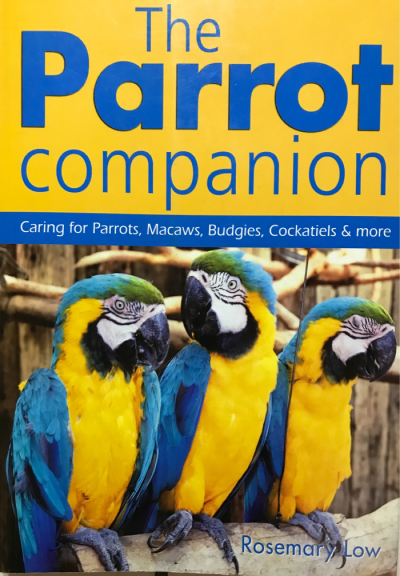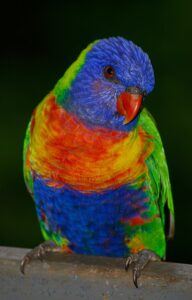If you need a good source of information about parrots in general, a book is often a better choice than Google. Here we review The Parrot Companion by Rosemary Low. Does it serve that need for you? Read this review to find out.
Who Is This Book For?
We bought this book soon after we brought our own African grey parrot home for the first time. That was several years ago, and we have consulted it many times since then.
The Parrot Companion is mainly aimed at those who are thinking of getting a parrot as a pet. Inexperienced or first-time parrot owners will find its content invaluable too.
If you are contemplating a parrot as your next pet, the book will give you valuable insights into the pros and cons of owning one.
The book then moves on to discussing the choice of parrot, and all of the many aspects of caring for it.
It tries to make you look beyond the fun side of parrot ownership, and to prepare you for the challenges that it brings. The author really wants you to consider whether buying a parrot is the right thing for you to do.
About The Author
Rosemary Low certainly has the credentials to write about parrots.
She has cared for and written about birds for most of her life. She spent 8 years with zoos in the Canary Islands. There, she was curator of 2 of the world’s largest collections of parrots.
She has written more than 20 books on birds, most of them about parrots. She is also credited with writing several articles and scientific papers on birds.
In 1989 she co-founded the World Parrot Trust, and edited its magazine for several years. World Parrot Trust is an international charity dedicated to the protection of parrots.
Her 3 main goals are said to be:
to widely publish information which will lead to a better standard of care for captive birds, to reduce the demand for wild-caught parrots, and to promote and assist with parrot conservation projects
Parrots As Pets

This is the title of the opening chapter.
As it suggests, it attempts to help readers to decide whether a parrot is an appropriate pet for them.
If you are already excited by the idea of owning a parrot, this could well be a downer for you.
Rosemary Low emphasizes the responsibility that comes with owning a parrot, and the commitment needed to care for it successfully.
For much of this chapter she lists several challenges and potential problems that parrot ownership brings.
Although she does mention the pleasures and benefits, she discusses these very briefly by comparison.
You can be forgiven for thinking that the writer is trying to dissuade you from owning a parrot.
As a long-time parrot owner, I believe that she is simply trying to address the very avoidable problem of parrots that end up unwanted or neglected.
Often, this happens when unsuitable owners become disillusioned with their parrot ownership experience.
Even though this approach may not go down well with all readers, I agree with it. Far too many people believe that owning a parrot is little different to owning a dog or a cat.
When reality hits home it’s inevitably the parrot that suffers.
Just by the way, if you don’t want to incur the expense of buying a book only to discover that you are perhaps not the best fit for parrot ownership, try to first read our article 7 Things to Consider Before Getting an African Grey Parrot.
It focuses on African grey parrots, and doesn’t cover all of the same ground that the book does. But many ownership issues are common to all parrot species, and this article could serve as a useful starting point for you.
It might also save you a little money.
Species Profile

If you’re not sure which kind of parrot you should get, the next chapter could help you decide.
It mentions several commonly kept companion parrots, and talks about some characteristics of each.
Plenty of color photographs make it easy to identify each species or even sub-species.
This is helpful when there are notable differences between sub-species, such as those within the Amazon and Conure groups.
A useful table categorizes the loudness as well as the shrillness of the calls that the different birds make. This table also includes a mimicry score for each category.
Rather than being based on any scientific measure, these ratings appear to be subjective, and based on the author’s personal assessments.
Considering Low’s many years of experience with these birds though, I presume that her table is accurate enough for the purposes of this book.
Another table rates birds according to their suitability for families with small and older children. Again, these scores appear to reflect Ms. Low’s own opinion. She admits that “parrots are highly individualistic, thus generalizations are not always accurate”.
She advises that the ratings only be used as a guide and describes the criteria and some of the assumptions that she used to determine the scores.
Curious to know how she rates our favorite bird? According to her, the African grey parrot is not recommended for families with small children, but is fine for a family with older kids.
Preparation And Arrival
Having decided that you’re up to the task of caring for a parrot, you’ve probably chosen which species is the one for you.
Your next steps are to work out what cage, equipment and other stuff you need. After that, you will have to think about how to settle your new pet into its strange new home.
The next 2 chapters are intended to help you with these decisions.
There are sound recommendations about the types of cages and accessories to buy.
There is also sensible advice on what age of parrot to get, where to buy it, and whether to consider acquiring an unwanted parrot. Low then discusses how to acquaint a parrot with its new environment, what precautions to take, and more.
In general, she does not mention specific products or vendors, but helps you to make an informed decision when the time comes.
There is also simple, practical advice on how to reduce the likelihood of your parrot escaping, and what to do in the event that it does.
There is one situation unexpectedly covered in the book, and which parrot owners seldom consider. That is the value that many parrots have to thieves, and the risk of your parrot being stolen.
Behavioral Problems of Parrots and Basic Parrot Training
Next is a fairly comprehensive section dealing with the most common problematic parrot behaviors.
Screaming, biting, feather-plucking and fearfulness; these are issues that most owners will encounter at some point in their relationship with their feathered pets.
Low expertly explains the possible origins of these problems, how to reduce the chances of them occurring, and how to deal with them if they do.
The few training techniques taught in the book are basic. Yet, they are enough to empower the novice parrot owner with some confidence when approaching the management of his or her pet’s behavior.
Food For Parrots
Diet is one of the most important aspects of parrot care, and plays a big role in determining your parrot’s longevity and general state of health.
Ms. Low is clearly aware of this and pays particular attention to it in the section dedicated to feeding.
She discusses various types of foods that can be fed to parrots, from seeds and pellets, to nuts, fruits, vegetables and even edible weeds.
There is plenty of useful reference material in this section, including a table indicating recommended proportions of each, of seeds and pellets, fruit, vegetables and pulses, for several different parrot species.
More useful data is provided for protein and fat content for different seeds. There is nutritional information for several types of nuts, and the vitamin content of certain fruits.
The various tabled lists are not exhaustive by any means. I presume this is due to space constraints, but they are handy for quick-reference.
If you need more, let me also remind you that we have a long and ever-expanding list of foods for parrots. Almost all of these are accompanied by handy and comprehensive nutritional information tables.

Parrot Health and Grooming
One important aspect of parrot care is the ability to identify and treat illnesses. Another is to maintain basic preventative hygiene.
The book covers common parrot afflictions, diseases, toxicity and injuries in varying detail, and offers advice on how to deal with them.
It also deals with parrot grooming, and maintaining its beauty, as the author calls it. Among other things, easy-to-understand instructions are provided for safely clipping a bird’s nails and for keeping its beak in good trim.
If you succeed in keeping your parrot healthy until it reaches a ripe old age, the short section about recognizing the signs of ageing will be useful.
Other than some dietary tips though, the book provides no other information on managing bird an aging. Given the level of detail found in other areas of the book, I guess I expected a little more.
Re-Homing a Parrot
The book concludes with a chapter that, in a way, links back to the start of the book.
There, Rosemary Low tries to make readers aware of the challenges and pitfalls that come with parrot ownership. In doing so, she hopes to get unsuitable potential owners to recognize this before it’s too late, and so increase the likelihood of parrots ending up with good carers.
She addresses the all-too-frequent and unfortunate need to re-home a parrot. It seems clear that successful re-homing is not as easy a task as it may seem, and is seldom achieved. She therefore tries to offer advice that she hopes will help owners to identify the best possible outcomes for their birds.
Given the importance of its content, I wonder whether this section should not rather appear at the beginning of the book instead of at the end. Perhaps it should even be merged with the very first chapter.
Pros
- Lots of helpful information to help you decide whether owning a parrot is right for you – and for the parrot.
- Plenty of good, practical advice for choosing, owning and caring for a parrot.
- Contains a good amount of well laid out reference material.
- The author clearly places the interests of the birds first
Cons
- Covers several kinds of parrots. You may find it a little thin on specifics for your species, if you have already chosen one.
- The book was first published in 2006. Some minor information relating to specific organizations might be outdated.
Conclusion
It’s not hard to deduce that Ms. Low has a strong emotional connection to parrots. The information and advice that she offers is never shared in a detached, clinical way, but in an anecdotal style that allows this emotional bond to come through.
To me, there is no doubting the integrity of her intentions in writing this book, and her writing style makes the information it contains easily accessible.
The book was published in 2006. While the information and advice provided is still valid today, some contact and other details of organizations and publications provided at the end of the book may be outdated.
In this age of Google search that should not pose too much of a problem.
Although the book covers a wide range of topics, it is not encyclopedic in its detail. To be so it would have to be a whole lot longer than it is. It should probably not be the only title about general parrot care on your reading list.
The book contains a reasonable amount of material which is specific to the African grey, but it makes up only a small portion of the book’s content. For regular visitors to our website, who are presumably mostly interested in grey parrots, this detracts from its value a little.
For that reason, our score of 4.0 out of 5 is slightly lower than it would otherwise have been. Having said that, if you do own a parrot, or are considering getting one, it is a very handy and valuable source of parrot information.


A very nice and interesting article. It is really nice that you presented information about the author and the work she has done on birds during her life. I never thought that owning a parrot is that demanding and complicated.
Very good work
Regards,
Anestis
Thank you Anestis. Parrots are really only demanding if they are bored and don’t get enough mental stimulation and social contact with their owners. Spend enough quality time with them and they’re amazing to be with.
Regards
Frank
I found your book on parrots as pets to be very interesting, and I have experienced owning pets has been my best medicine for managing my health problems. I have been considering adding a new pet to my home, and a parrot sounds like a fun pet. I will add this book to my book wish list, and do you happen to know how parrots and dogs would get along in the same home?
Jeff
Hi Jeff. Glad to hear that you’re enjoying the therapeutic power of pets.
A parrot would be an excellent pet so long as you have the time and commitment to fulfill it’s social and other needs.
As for having parrots and dogs in the same home, it is possible. We’ve had up to 3 dogs in our house together with the parrot. BUT, I would not pin any hopes on these creatures “getting along” with each other, neither would I risk them being near each other in an unsupervised situation when the bird is out of its cage.
I have written an article which you might find useful. It’s called 7 Things To Consider Before Getting An African Grey Parrot and it deals with having parrots and dogs in the same household. This article should also help you to assess whether an African grey is a good fit for you and your environment. I hope you find it helpful.
Thanks for your input. Ask away if you have any more questions.
Frank